49 years ago, when I was 12, I built my first wooden ship model. She was Model Shipways’ lovely clipper Young America. The project took 2 years. By the time I got to the rigging I was thinking how cool it would be to build a ship like this but large enough to actually sail. Over the years, and a number of ship models later, I finally had the opportunity to try it out.
I had spent a year and a half as a professional house carpenter when I was younger (now I’m an actuary) and had a reasonable amount of wood shop experience. In addition, I had led a group of friends in building a strip planked canoe. So with all that experience, I identified the Leon (built in Norway in 1880) as the basis for the project. She is featured in Underhill’s Plank-on-Frame Models and Scale Masting & Rigging (Brown, Son and Ferguson, Glasgow, 1968) so I had a good source for detail.
My wife, Pat, constructed a web site to document the construction at each step – www.littleleon.org. Here, I’m just going to show a few of my favorite pictures. If you want to see the details of her construction you can visit the web site. But first, where are we now:
| Here's Leon |
Here's Little Leon |
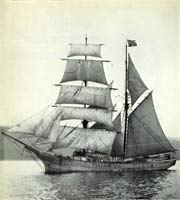 |
 |
Since this picture of Little Leon, two staysails have been set between the two masts but I still have to make the fore course, the lowest square sail. We’ve had Little Leon out four times since this picture was taken but everyone who comes is in the boat so we have no new pictures! The fore course will be made this winter for the 2009 sailing season and we’ll get some pictures with her full suit of sails. One person can sail with all 7 fore-aft sails and one other person is needed to set the square sails.
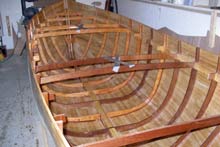 |
The hull is strip planked with tongue and groove planks. The planks are glued together and screwed to 14 forms attached to a strong back. |
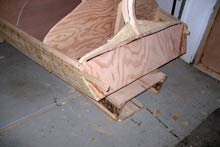 |
After the planking was completed the outside was fiber glassed, the forms removed and the inside was fiber glassed. The frames and deck beams are cut from the molds that were used for planking. |
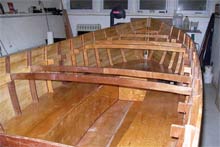 |
The water ballast tank holds 2,400 lbs of water. The top of the tank serves as seats. Water is pumped in when she’s launched and pumped back out before being loaded back on the trailer. While the tank is filling or emptying stability is a problem as the water sloshes around. When the tank is full this is not a problem as the water can’t slosh around much. |
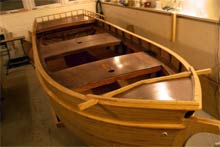 |
Now the hull is complete and we’re ready to start the masting and rigging. |
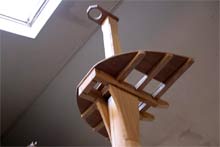 |
All the spars are made from 4 pieces glued together for strength and to ensure straightness. This is the fore mast top ready to receive the fore topmast. |
 |
The masts are shown in their stowed position. The idea is to stow the masts without removing the rigging to make set up and take down times reasonable. Each takes about an hour. |
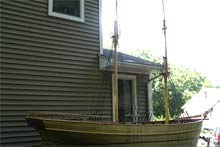 |
All the standing rigging is complete. |
 |
The first sail test with just the mainsail and the three headsails. The headsail sheets all lead to the after cockpit. |
 |
The upper topsail has 6 buntlines that furl the sail. These six all come into a single line so they can all be pulled at the same time. The two sheets also come into a single line for the same reason. The single line for the buntlines is the same as the single line for the sheets. When the sail is set, the sheets are pulled in and the buntlines simultaneously pay out. When the sail is furled, the buntlines are pulled in and the sheets simultaneously pay out. This way there are no loose ends to get tangled. |
 |
The square sails are furled as well as the main topsail. The outer jib needs adjusting! The inner jib and the outer jib are pretty much impossible to see from the helm and they have to be set by feel unless a crew member who can see them can offer advice. |
 |
The topgallant is in the middle of being set. |
 |
All sails flying! Except for the two staysails and the fore course. We’ll have pictures of those later in 2009. |
Take a look at the movie clip at www.littleleon.org and if you’re really ambitious you can peruse many detailed construction photos as well as pictures of Little Leon under sail. Little Leon is my dream but the web site is my wife’s work. Thanks to friends and family for sharing their photos for the web site.
***** |

